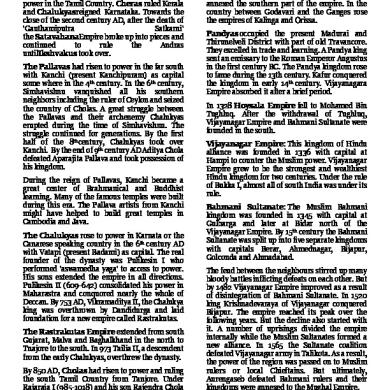Hist. 120- Delhi Sultanate And Regional Kingdoms.docx
This document was uploaded by user and they confirmed that they have the permission to share it. If you are author or own the copyright of this book, please report to us by using this DMCA report form. Report DMCA
Overview
Download & View Hist. 120- Delhi Sultanate And Regional Kingdoms.docx as PDF for free.
More details
- Words: 708
- Pages: 1
While turmoil was brewing up and kingdoms were rising and falling in the north, the south India remained comparatively calm and stable. The Pallavas, Cholas and Pandyas shared the power in the Tamil Country. Cheras ruled Kerala and Chalukyasreigned Karnataka. Towards the close of the second century AD, after the death of 'Gauthamiputra Satkarni' the SatavahanaEmpire broke up into pieces and continued to rule the Andras untilIkshvakus took over. The Pallavas had risen to power in the far south with Kanchi (present Kanchipuram) as capital some where in the 4th century. In the 6th century, Simhavishnu vanquished all his southern neighbors including the ruler of Ceylon and seized the country of Cholas. A great struggle between the Pallavas and their archenemy Chalukyas erupted during the time of Simhavishnu. The struggle continued for generations. By the first half of the 8thcentury, Chalukyas took over Kanchi. By the end of 9th century AD Aditya Chola defeated Aparajita Pallava and took possession of his kingdom. During the reign of Pallavas, Kanchi became a great center of Brahmanical and Buddhist learning. Many of the famous temples were built during this era. The Pallava artists from Kanchi might have helped to build great temples in Cambodia and Java. The Chalukyas rose to power in Karnata or the Canarese speaking country in the 6th century AD with Vatapi (present Badami) as capital. The real founder of the dynasty was Pulikesin I who performed 'aswamedha yaga' to access to power. His sons extended the empire in all directions. Pulikesin II (609-642) consolidated his power in Maharastra and conquored nearly the whole of Deccan. By 753 AD, Vikramaditya II, the Chalukya king was overthrown by Dandidurga and laid foundation for a new empire called Rastrakutas. The Rastrakutas Empire extended from south Gujarat, Malva and Baghalkhand in the north to Tnajore to the south. In 973 Tailia II, a descendent from the early Chalukyas, overthrew the dynasty. By 850 AD, Cholas had risen to power and ruling the south Tamil Country from Tanjore. Under Rajaraja I (985-1018) and his son Rajendra Chola I (1018-1048) Cholas conquered the whole of Tamil Country. They went as far as Ganges and asserted their power over Ceylon, Nicobar Islands, parts of the Malay peninsula and the Indian
Archipelego. Rajendra defeated Manipala I of Bengal. He also vanquished Chalukyas at Musangi. The Chola Empire declined after Rajendra Chola Kulathunga. The Pandyas annexed the southern part of the empire. In the country between Godavari and the Ganges rose the empires of Kalinga and Orissa. Pandyas occupied the present Madurai and Thirunelveli District with part of old Travancore. They excelled in trade and learning. A Pandya king sent an emissary to the Roman Emperor Augustus in the first century BC. The Pandya kingdom rose to fame during the 13th century. Kafur conquered the kingdom in early 14th century. Vijayanagara Empire absorbed it after a brief period. In 1328 Hoysala Empire fell to Mohamed Bin Tughluq. After the withdrawal of Tughluq, Vijayanagar Empire and Bahmani Sultanate were founded in the south. Vijayanagar Empire: This kingdom of Hindu alliance was founded in 1336 with capital at Hampi to counter the Muslim power. Vijayanagar Empire grew to be the strongest and wealthiest Hindu kingdom for two centuries. Under the rule of Bukka I, almost all of south India was under its rule. Bahmani Sultanate: The Muslim Bahmani kingdom was founded in 1345 with capital at Gulbarga and later at Bidar north of the Vijayanagar Empire. By 15th century the Bahmani Sultanate was split up into five separate kingdoms with capitals Berar, Ahmednagar, Bijapur, Golconda and Ahmadabad. The feud between the neighbours stirred up many bloody battles inflicting defeats on each other. But by 1482 Vijayanagar Empire improved as a result of disintegration of Bahmani Sultanate. In 1520 king Krishnadevaraya of Vijayanagar conquered Bijapur. The empire reached its peak over the following years. But the decline also started with it. A number of uprisings divided the empire internally while the Muslim Sultanates formed a new alliance. In 1565 the Sultanate coalition defeated Vijayanagar army in Talikota. As a result, the power of the region was passed on to Muslim rulers or local Chieftains. But ultimately, Aurengaseb defeated Bahmani rulers and their kingdoms were annexed to the Mughal Empire.
Archipelego. Rajendra defeated Manipala I of Bengal. He also vanquished Chalukyas at Musangi. The Chola Empire declined after Rajendra Chola Kulathunga. The Pandyas annexed the southern part of the empire. In the country between Godavari and the Ganges rose the empires of Kalinga and Orissa. Pandyas occupied the present Madurai and Thirunelveli District with part of old Travancore. They excelled in trade and learning. A Pandya king sent an emissary to the Roman Emperor Augustus in the first century BC. The Pandya kingdom rose to fame during the 13th century. Kafur conquered the kingdom in early 14th century. Vijayanagara Empire absorbed it after a brief period. In 1328 Hoysala Empire fell to Mohamed Bin Tughluq. After the withdrawal of Tughluq, Vijayanagar Empire and Bahmani Sultanate were founded in the south. Vijayanagar Empire: This kingdom of Hindu alliance was founded in 1336 with capital at Hampi to counter the Muslim power. Vijayanagar Empire grew to be the strongest and wealthiest Hindu kingdom for two centuries. Under the rule of Bukka I, almost all of south India was under its rule. Bahmani Sultanate: The Muslim Bahmani kingdom was founded in 1345 with capital at Gulbarga and later at Bidar north of the Vijayanagar Empire. By 15th century the Bahmani Sultanate was split up into five separate kingdoms with capitals Berar, Ahmednagar, Bijapur, Golconda and Ahmadabad. The feud between the neighbours stirred up many bloody battles inflicting defeats on each other. But by 1482 Vijayanagar Empire improved as a result of disintegration of Bahmani Sultanate. In 1520 king Krishnadevaraya of Vijayanagar conquered Bijapur. The empire reached its peak over the following years. But the decline also started with it. A number of uprisings divided the empire internally while the Muslim Sultanates formed a new alliance. In 1565 the Sultanate coalition defeated Vijayanagar army in Talikota. As a result, the power of the region was passed on to Muslim rulers or local Chieftains. But ultimately, Aurengaseb defeated Bahmani rulers and their kingdoms were annexed to the Mughal Empire.
Related Documents

Hist
May 2020 25
Delhi
October 2019 49
Delhi
May 2020 25
Delhi
November 2019 42
120
November 2019 43More Documents from ""

Hist. 145- Position Paper.docx
June 2020 0
Khaosatpost
April 2020 0
Dubi2008a2
May 2020 0
Dethitotnghiep
May 2020 0
